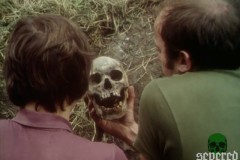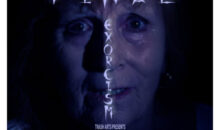A Ghost Story for Christmas – The Signalman, Stigma, The Ice House Review from BFI!
Since we’re in the closing month of 2016, I figured I’d dig in my collection and dust off a Christmas review with a difference. Way back in the 1970s, the BBC decided to show a Christmas chiller either on Christmas Eve or near about. They called them A Ghost Story for Christmas. Based on the works of classic writers, M.R. James or Charles Dickens (aside from two later modern tales), they were minimal and very atmospheric. The series was revived in the mid-2000s to excellent applause, but unfortunately didn’t last very long. If there’s one thing the UK do well, it’s tell a blooming good ghostly yarn.
Fast forwards to a few years back and the hugely successful, BFI (British Film Institute), label — who are renowned for finding and putting out so many hundreds of rare and discovered films from around the globe — pushed the A Ghost Story for Christmas series out in packs of two or three episodes. Some tales are held in high regard and have lost none of their power over the decades. Others are… well, let’s just say, they don’t fit in well with a late night terror filled story by the fireplace.
The first story in this volume sets the bar at such a high standard that neither of the other two could put up a fight. I’m talking about The Signalman, based on the hair raising short tale by Charles Dickens.
We open to a bowler hat wearing chap strolling across the English countryside around the early 1900s. Hearing a train, he changes direction and follows the sound. Finding a deep embankment which looms over a dark railway tunnel and lines, he leans over seeing a uniformed signalman deep in the valley.
“Hello!” he calls, “Hello below there!” The Signalman stares upwards with an expression of fear and bewilderment. Once he’s climbed down and is face to face, he makes conversation. “My, this must be a very lonesome spot to occupy, is it not?” However the signalman isn’t very chatty, he carries on staring with that same expression.
“There’s nothing to fear.” The traveller realises the man is scared. Once the signalman speaks, he says he thinks he’s seen him prior, in the dark tunnel. The chap denies this. They head to the signal box, sit and have a cup of tea out of the ice cold air. We get an insight into the cramped and lonely world of solitude which old English signalmen endured. He is well educated, but lost, and haunted by so far unknown things. He turns sometimes, as if hearing a bell which doesn’t exist.
The traveller falls asleep and wakes up at night. He explains that he felt drawn to the area and doesn’t know why exactly. As the conversations go on, he says, “An accident on this line must be a terrible thing. In the tunnel.” The signalman’s mood darkens at this. “The tunnel…. is the worst place to be feared. The… wreckage becomes compressed in the small space… If a fire breaks out…” his memory is drifting. We know he’s witnessed terrible things.
Time is ticking by. The traveller bids him farewell and agrees to return. He promises not to call from above the next time. Upon his return, they sit at night again in the signal box. The signalman decides he must tell him everything of what has happened before.
It all ends in a cold and shattering way based in and around the dark tunnel. It all involves the appearance of a hooded spectre of a man before accidents happen. Though to some, I suppose, the conclusion may feel very dated, but no one can deny the slow and chilling build-up. Like an episode of Sapphire and Steel –which is renowned by many as still the scariest series of the ‘70s — The Signalman holds the viewer in dread without flashing effects or action. All darks, gloom and fire reds, it presents itself as relying on acting, a minimum cast, and the imagination. Denholm (Raiders of the Lost Ark, Zulu Dawn) Elliot and Bernard (Hitler’s SS, The Young Victoria) Lloyd are both superb throughout.
So onwards to Stigma, the second short story. It showed on TV the following year, and is so different to The Signalman, that it is hard to place it in the theme of the Ghost Stories series as a whole. Keep in mind, prior to these, were old tales by M.R. James. Stigma isn’t based on a classic, it’s written for the series itself.
Katherine and her daughter, Verity are driving through — where else? — the English countryside on their way home. They live in a nice house with a big garden near a field covered in old rune like stones. One of these said stones has been uncovered whilst workmen have moved the undergrowth, and trees from their garden. It is agreed to move the stone. To lift it with their truck and pulley. This doesn’t work at all, however, as the slab raises slightly, a wind assaults Katherine only, unnoticed by everyone else. She heads inside in a trance. In fact, when hubby, Peter, calls, she speaks to him in a deadly monotone voice. In her mind, the building is shaking. The men give in on shifting the slab, figuring it best to return tomorrow with a better way.
Verity wanders into the fields to wait for her Dad. Katherine finds herself bleeding. In the bathroom, she strips off but cannot find a wound. Every time she dresses she bleeds. Frantic, she wraps a gauze around herself.
That night, Peter is woken by noises downstairs. He strolls down and as he switches on the kitchen light, an onion falls from mid-air. The oven is on, he switches it off, and a knife by his side moves on its own. Puzzled, he checks around, then returns to bed.
Morning comes and the lads have brought a big-assed tow truck with a big mad crane on it. This’ll shift it! When they reveal what is under the monolith, Peter finds his wife unconscious and bleeding heavily from a wound he cannot find. As the workmen discover more and more things under the slab, things get a lot worse…
A world apart from The Signalman, and bleeding pure and total ‘70s, Stigma is merely okay. It delivers gore and creepiness, but fails at the end, feeling rather rushed. The cast work well with the basic script they have. Stigma could have been so much more, but it is watchable.
Lastly we come to The Ice House. Now then, critics and reviewers across the years stab at this one, claiming it to be the weakest of all the Ghost Story series. Harsh, but I can see why.
Paul, recently divorced, is staying at a health spa deep in — get this — the English countryside (I sense a running theme here), which is run by brother and sister, Clovis and Jessica. They are as weird as the twins in Vampire Circus (see review here) and their place is filled by very vacant elderly people, who are hard to communicate with. The siblings have a habit of debating life itself, mainly how it ends, and if life is so horrid, then should the end of life be enjoyed? That kind of thing.
In the massage room, a staff member, Bob, complains of having “the cools,” and then begs Paul to aid his escape from the grounds. That night, Paul hears a scream in the dark but he assumes it to be an animal. The next morning when he enquires about Bob, he’s told he went away.
“Have you seen the ice house?” he is taken down to the gardens. On the way, he is besotted by the fragrance of a vine which grows by the ice house — a stone hut in the middle of the messy overgrown weeds and stuff. Paul finds himself returning again to the vine.
We witness Clovis and Jessica kissing by the vines which move in time to their hugs. One afternoon, as Paul plays croquet on the lawn, he is struck by what Bob called “the cools.” They are bone deep chills. There’s also a hole in his bedroom window in the shape of one of the flowers on the vines.
As the tale continues, Paul needs to be with the vine again, and he needs to explore the ice house properly…
The Ice House is all British stiff upper lip, and everybody seems so void or smarmy. There’s no one to root for. They are all unlikeable. The acting seems so off, as well, like nobody gave a toss! Well, apart from Geoffrey (Blake’s 7, An American Werewolf in London, Sons and Lovers) Burridge, as Clovis, who is fantastic. If The Ice House is creepy, it’s down to him. (His life was sadly cut short before he reached the age of forty as he died of AIDS in 1987.) I think another problem is, nothing happens for way too long so your attention drifts. Still, the scenery is beautiful.
So, Merry Christmas. Perhaps you feel like sitting by the warm fire as the snow falls outside, and you want to enjoy a gothic little piece of ghostly horror. The Signalman is just the thing. (On a personal note The Signalman was one of my Gran’s favourite chillers. Keep in mind that my dear Gran loved Predator and They Live, amongst others as well.) It is also worth tracking down the other M.R. James volumes with Lost Hearts, The Ash Tree, The Treasure of Abbot Thomas, The Stalls of Barchester, A Warning to the Curious, and the 2005 revivals, A View from a Hill, Number 13.
AKA: Ghost Stories: Classic adaptations from the BBC, Ghost Stories: Volume 4
Directed by: Lawrence Gordon Clark, Derek Lister
Written by: Charles Dickens, Clive Exton, John Bowen
Produced by: Rosemary Hill
Cinematography by: David Whitson, John Turner
Editing by: Peter Evans, Dave King, Tony Woollard
Music by: Stephen Deutsch
Cast: (The Signalman) Denholm Elliott, Bernard Lloyd (Stigma) Kate Binchy, Peter Bowles, Maxine Gordon (The Ice House) Jon Stride, Geoffrey Burridge, Elizabeth Romilly
Years: 1976/1977/1978
Country: United Kingdom
Colour: Colour
Language: English
Runtimes: 39min/ 32min/ 34min
Distributor: BFI



































